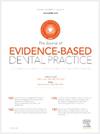HOW TO REPORT OUTCOMES IN CLINICAL DENTAL RESEARCH
IF 4
4区 医学
Q1 DENTISTRY, ORAL SURGERY & MEDICINE
引用次数: 0
Abstract
Outcomes, also known as endpoints, are a critical component in clinical research evaluating the effects of healthcare interventions. The validity of a clinical study depends on the appropriate selection and usage of outcomes. Therefore, complete, accurate, and transparent reporting of outcomes is essential for the critical appraisal of a study's methods and findings. However, empirical research has shown that the reporting of outcomes is often incomplete and selective in clinical dental research, hindering evidence synthesis and evidence-based dental practice. To improve and standardize outcome reporting, reporting guidelines that provide specific guidance for all types of outcomes, namely the SPIRIT-Outcomes 2022 and CONSORT-Outcomes 2022, have been developed and released recently. In addition, reporting guidelines for certain types of outcomes have also been published, including harms, patient-reported outcomes (PROs), and surrogate outcomes. The present article describes common classifications of outcomes, current issues in outcome reporting, and using reporting guidelines to standardize and improve outcome reporting in clinical dental research. The role of core outcome sets in outcome reporting is also discussed. This article aims to provide guidance and suggestions to help improve the completeness and transparency of outcome reporting and reduce relevant research waste in clinical dental research.
如何报告临床牙科研究的结果
结果,也称为终点,是临床研究中评估医疗干预效果的关键组成部分。临床研究的有效性取决于结果的适当选择和使用。因此,完整、准确和透明的结果报告对于研究方法和发现的批判性评估至关重要。然而,实证研究表明,临床牙科研究结果的报告往往是不完整的和选择性的,阻碍了证据合成和循证牙科实践。为了完善和规范结果报告,最近制定并发布了针对所有类型结果提供具体指导的报告指南,即《SPIRIT-Outcomes 2022》和《conner - outcomes 2022》。此外,还发布了某些类型结果的报告指南,包括危害、患者报告的结果(PROs)和替代结果。本文描述了常见的结果分类,结果报告中的当前问题,以及使用报告指南来规范和改进临床牙科研究的结果报告。还讨论了核心成果集在成果报告中的作用。本文旨在为提高临床牙科研究结果报告的完整性和透明度,减少相关研究浪费提供指导和建议。
本文章由计算机程序翻译,如有差异,请以英文原文为准。
求助全文
约1分钟内获得全文
求助全文
来源期刊

Journal of Evidence-Based Dental Practice
DENTISTRY, ORAL SURGERY & MEDICINE-
CiteScore
6.00
自引率
16.70%
发文量
105
审稿时长
28 days
期刊介绍:
The Journal of Evidence-Based Dental Practice presents timely original articles, as well as reviews of articles on the results and outcomes of clinical procedures and treatment. The Journal advocates the use or rejection of a procedure based on solid, clinical evidence found in literature. The Journal''s dynamic operating principles are explicitness in process and objectives, publication of the highest-quality reviews and original articles, and an emphasis on objectivity.
 求助内容:
求助内容: 应助结果提醒方式:
应助结果提醒方式:


